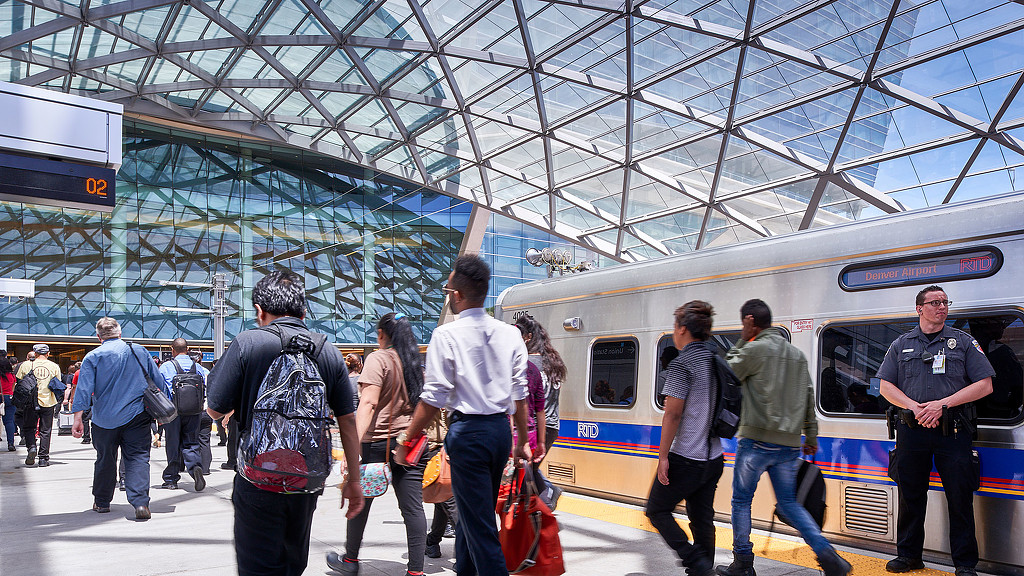Reimagining a Safer, More Equitable Daily Commute
July 08, 2020 | By Christopher Rzomp
Editor’s Note: This post is part of our ongoing exploration of how design is responding to the COVID-19 pandemic.
Just four months ago, it was unfathomable to think that commuting via public transit could endanger one’s personal health. But as cities and employers contemplate the return to the office, that is now the challenge before us.
The COVID-19 pandemic will leave a long-lasting impression on our transportation systems and workplaces. As we strive to make adjustments to help our society operate at reduced capacity, we know that the permanent solution to this crisis will come not from design but from healthcare. Like other new viruses throughout history, what will ultimately make people feel at ease is a commonly distributed vaccine or treatment to mitigate the virus’s impact.
But with such a solution potentially many months away, how do cities and their transit networks carry on? How do those of us with an individual commitment to live car-free, or who have no other means of transportation, navigate the return?
As commuters who are wary about public transportation safety return to their daily commutes, there will be an instinctual reaction to revert to single-occupancy vehicles to protect their health. The CDC recently issued guidance encouraging commuting alone by car, which the American Public Transportation Agency (APTA) is urging them to reconsider. After all, such a practice could set cities and regions back in their long-held goals on climate change, congestion, and equity. For example, a study by Work Research Group found that in San Francisco, the average commute time could more than double if people ditch public transit in favor of their cars.
So we see a new call to action — to operators of public transit systems, the workplaces that benefit from them, and their riders — to do their part in helping public transportation systems adapt to our new reality. Here are four strategies to think about as we answer that call and create a public transit commute that prioritizes people’s safety and equity:
1. Workplace policy changes could lead to a new normal.For workplaces that begin to reopen, providing guidance and monitoring of their staffs’ commutes will be an important part of the transition. But how to go about that in a purposeful way that drives positive forms of social change is a challenging question. In my work, I’m seeing promising answers in Transportation Demand Management (TDM) policies and the use of Transportation Management Plans (TMPs).
Historically, TMPs were developed to manage organizations’ “transportation footprints” and help them do their part in meeting regional congestion goals. Core components of TMPs include setting goals for how much of the workforce is working from home and commuting via methods other than single-occupancy vehicles, as well as how on-site parking can be reduced. Also included within this process is identifying programs to support employees if they would like to change how they commute.
In TDM work Gensler performed for a confidential corporate client in the Atlanta region, we connected with Georgia Commute Options, a federally funded program that provides assistance to employers in reducing the workforce’s single-occupancy vehicle commuter trips. Programs like this encourage tangible action and the pursuit of targets that can be clearly measured, and integrated goals in managing health could now be a part of this tool. We can monitor, understand, and evaluate how many employees are using public transportation, working from home, or working at job sites in light of the phased reopening benchmarks that are being established in many cities. Merging the management of workplace commuting with the support of employee health will be an important aspect of successfully reengaging our workplaces.
2. Short-term adjustments can build public confidence.As the opportunity to regain daily ridership becomes real, transit operators will first have to address the fundamental concerns that have been highlighted by the pandemic, like cleanliness and personal space on trains and buses. Given sterilization concerns, providing hand sanitizer pumps throughout stations and even on busses and trains could help riders maintain a feeling of cleanliness.
More dramatic steps may also be effective. Operationally, continuous cleaning and maintenance — and open communication about how often those cleanings are happening — could make a big difference. In May, Amtrak made the decision to close its concourse at New York Penn Station for a deep cleaning, and the New York MTA announced its plan to suspend overnight subway service to thoroughly clean each train. While providing sure sanitary benefits, these moves can help rebuild confidence in the systems. And they aren’t a bad idea in normal times, either.
3. Equity must be a priority.A lack of affordable housing has forced many residents of low-income and communities of color to endure long commutes with limited access to reliable public transit. The COVID-19 pandemic has highlighted this disparity. In the U.S., 2.8 million transit riders — more than a third of total transit commuters — are considered “essential” during COVID-19, according to a report by TransitCenter. Many of these riders are low-wage service workers who depend upon mass transit for commuting, access to medical care, or basic shopping needs. Workers of color are more likely to lack a vehicle at home; to commute by public transit; and have one-way commutes of 60 minutes or longer, according to U.S. Census data obtained by Demos, a think tank. In order to remedy long-standing inequities and ensure that everyone — regardless of race, ethnicity, or class — has an efficient and affordable way to commute, cities must prioritize transit investment by increasing frequency, decreasing wait times, improving and expanding service, and engaging with community members in underserved neighborhoods.
4. Keeping riders informed can make all the difference.Some safety considerations will place a new premium on communication with riders. It will be important, for example, to provide additional space between users and transit staff. On buses, this means the use of back door only boarding to maintain distance between the bus operator and the riders. More impactful will be the limiting the number of passengers allowed on train cars or in buses, which will redefine the crush load factor of peak operations. Yet such limits could lead to frustration among riders who are expecting to be able to board the next train or bus. Providing information on space availability and changes in operation will be critical to managing rider expectations, so transit operators should explore new means of communication, such as developing applications to estimate live wait times and vehicle occupancy.
Flexible signage and wayfinding interventions will be an important part of this evolution. My colleagues Ty Osbaugh and Beth Ready have laid out ideas to address that challenge in the aviation realm, which will also be applicable here. Signage and wayfinding will need to be more nimble than ever, and keeping riders informed will be key in rebuilding their confidence and trust. And once again, more flexible and detailed communication from operators will also lead to a better overall passenger experience after the pandemic is over.
The pandemic is a real test for anyone with a stake in public transit. At this moment, we in the transportation community have a responsibility to be brave, patient, and responsible. Long-term issues of climate change and the resilience and efficiency of our cities also aren’t going anywhere. They should still inspire us to remain committed to public transportation, and to do whatever we can to restore confidence in it. The light at the end of the tunnel is not only a world in which the pandemic is over. It’s a world in which we have laid the foundation for more people to safely use public transportation than ever before, thereby creating a more equitable society and a healthier planet.
For media inquiries, email media@gensler.com.

